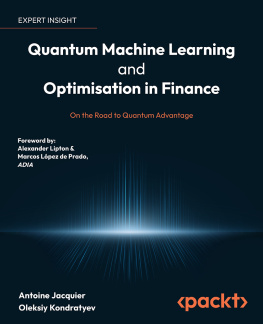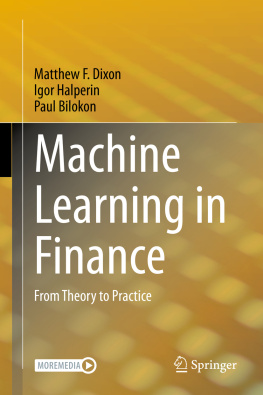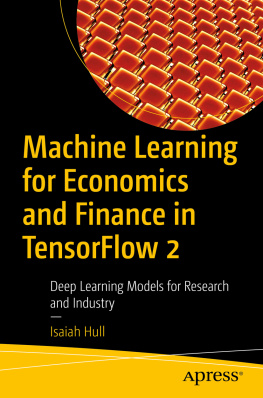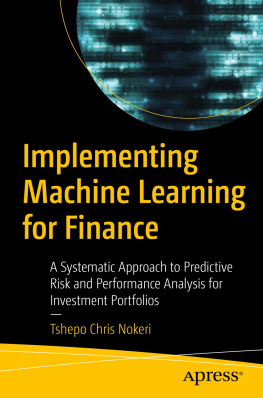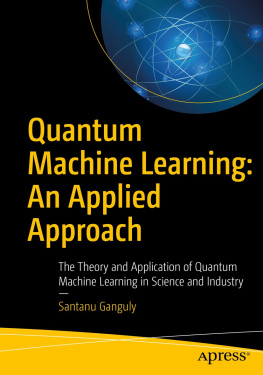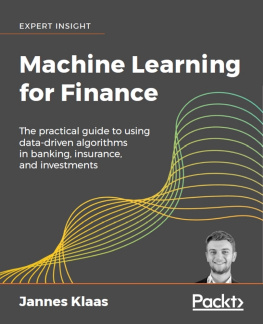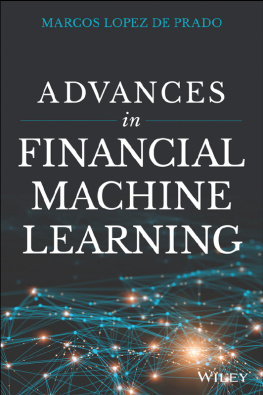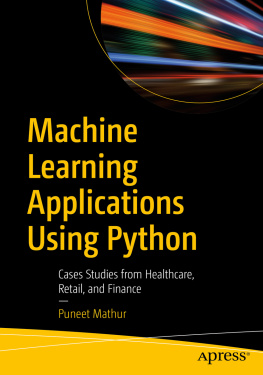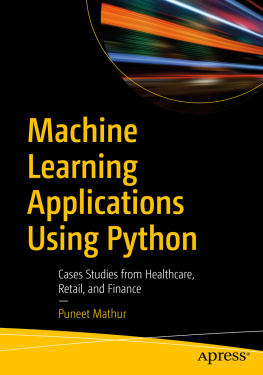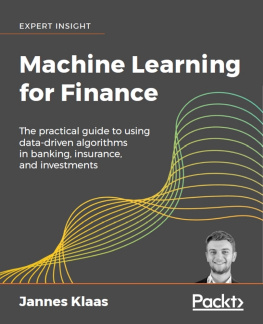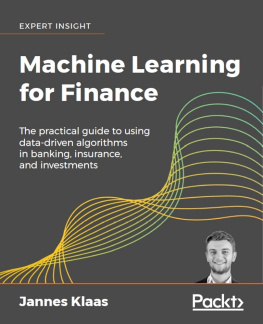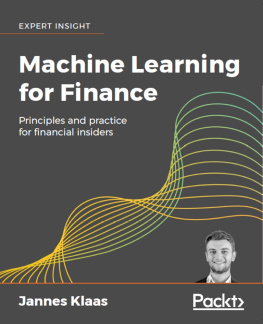Oleksiy Kondratyev - Quantum Machine Learning and Optimisation in Finance
Here you can read online Oleksiy Kondratyev - Quantum Machine Learning and Optimisation in Finance full text of the book (entire story) in english for free. Download pdf and epub, get meaning, cover and reviews about this ebook. year: 2022, publisher: Packt, genre: Computer. Description of the work, (preface) as well as reviews are available. Best literature library LitArk.com created for fans of good reading and offers a wide selection of genres:
Romance novel
Science fiction
Adventure
Detective
Science
History
Home and family
Prose
Art
Politics
Computer
Non-fiction
Religion
Business
Children
Humor
Choose a favorite category and find really read worthwhile books. Enjoy immersion in the world of imagination, feel the emotions of the characters or learn something new for yourself, make an fascinating discovery.
- Book:Quantum Machine Learning and Optimisation in Finance
- Author:
- Publisher:Packt
- Genre:
- Year:2022
- Rating:4 / 5
- Favourites:Add to favourites
- Your mark:
- 80
- 1
- 2
- 3
- 4
- 5
Quantum Machine Learning and Optimisation in Finance: summary, description and annotation
We offer to read an annotation, description, summary or preface (depends on what the author of the book "Quantum Machine Learning and Optimisation in Finance" wrote himself). If you haven't found the necessary information about the book — write in the comments, we will try to find it.
Quantum Machine Learning and Optimisation in Finance — read online for free the complete book (whole text) full work
Below is the text of the book, divided by pages. System saving the place of the last page read, allows you to conveniently read the book "Quantum Machine Learning and Optimisation in Finance" online for free, without having to search again every time where you left off. Put a bookmark, and you can go to the page where you finished reading at any time.
Font size:
Interval:
Bookmark:
Quantum Machine Learning Most overhyped and underestimated field at the same time
Iordanis Kerenidis
Why Quantum Computing? Quantum computing and AI will revolutionise and disrupt our society in the same way as classical digital computing did in the second half of the 20th century and the internet did in the first two decades of the 21st century.
Quantum computing (or, more generally, Quantum Information Theory) has been the subject of extensive research since the 1960s, but it was only in the last decade that progress on the hardware side has made it possible to test quantum computing algorithms; and it was only in the last several years that quantum computings supremacy was finally claimed as an experimental fact (i.e., a landmark experiment conducted on Googles 53-qubit Sycamore quantum chip [] ).
The story of quantum computing is, in this respect, similar to the story of AI: AI was born in the 1950s but then experienced two winters, when interest in AI and Machine Learning declined considerably (following the Lighthill report in the UK and the Speech Understanding Research debacle in the US in the 1970s, and the LISP collapse in the 1990s), before becoming widely used and adopted to the point that we can no longer imagine our life without it.
Even though we cannot rule out a quantum computing winter before quantum computing technology becomes embedded in everyday life to the same extent as the internet, smartphones, and AI, the whole range of quantum computing breakthroughs we have witnessed in the last few years makes it somewhat unlikely.
With recent advances in the field, we have finally reached the era of Noisy Intermediate-Scale Quantum (NISQ) computing [] . NISQ-era computers are powerful enough to test quantum computing algorithms and solve non-trivial real-world problems and establish quantum speedup and quantum advantage over comparable classical hardware.
However, it is likely that the first real-world production-level business applications will be a hybrid quantum-classical protocol, where most of the computation and data processing is done classically, but the hardest problems are outsourced to the quantum chip. In finance, discrete portfolio optimisation problems, which are NP-hard, are such examples and clear objectives to tackle.
Why Quantum Machine Learning? It is a combination of quantum computing and AI that will likely generate the most exciting opportunities, including a whole range of possible applications in finance, but also in medicine, chemistry, physics, etc. We have already witnessed the first promising results achieved with Parameterised Quantum Circuits trained as either generative models (such as Quantum Circuit Born Machine, which can be used as a synthetic data generator) or discriminative models (such as a Quantum Neural Network that can be trained as a classifier). The possible use cases include market generators, data anonymisers, credit scoring, and the generation of trading signals.
All the models and techniques mentioned so far rely on the existence of universal, gate model quantum computers. However, there is another type of quantum hardware quantum annealers which realise the principle of adiabatic quantum computing. Quantum annealers are analog quantum computers that are very well suited for solving complex optimisation problems that are NP-hard for classical computers. Optimisation problems form a large class of hard-to-solve financial problems, not to mention the fact that many supervised and reinforcement learning tools used in finance are trained via solving optimisation problems (minimisation of a cost function, maximisation of reward).
An example of discriminative machine learning problems solved using quantum annealers includes building a strong classifier from several weak ones the Quantum Boosting algorithm. The strong classifier is highly resilient against overtraining and against errors in the correlations of the physical observables in the training data. The quantum annealing-trained classifiers perform comparably to the state-of-the-art classical machine learning methods. However, in contrast to these methods, the annealing-based classifiers are simple functions of directly interpretable experimental parameters with clear physical meaning and demonstrate some advantage over traditional machine learning methods for small training datasets.
Another application of quantum annealing is in generative learning. In Deep Learning, a well-known approach for training a deep neural network starts with training a generative Deep Boltzmann Machine, typically using the Contrastive Divergence (CD) algorithm, then fine-tuning the weights using backpropagation or other discriminative techniques. However, generative training is often time consuming due to the slow mixing of Boltzmann (Gibbs) sampling. The quantum sampling-based training approach can achieve comparable or better accuracy with significantly fewer iterations of generative training than conventional CD-based training.
The main focus of this book is therefore on tackling practical real-world applications of Quantum Machine Learning (QML) algorithms executable on NISQ hardware rather than adopting the more traditional quantum computing textbook approach, diligently describing standard quantum computing algorithms (Shors, Grovers, ), the quantum hardware demands of which are well beyond the capabilities of NISQ computers. The focus is also on the hybrid quantum-classical computational protocols that reflect the most productive way of harnessing the power of quantum computing it is in tandem with classical computing that quantum computing solutions can provide maximum benefits to the users.
In this book, we cover all major QML algorithms that have been the subject of intensive research by the industry and that have shown early signs of potential quantum advantage. We also provide a balanced view of both analog and digital quantum computers and do not try to make a call on which quantum computing technology (superconducting qubits, trapped ions, neutral atoms, etc.) will be the eventual winner. The material is presented in a hardware-agnostic way with a strong emphasis on the fundamental characteristics of the algorithms rather than their hardware realisations, although we do not ignore the question of algorithms embedding and the practical limitations of the existing quantum computing hardware.
Why Finance? It is reasonable to expect that the incredibly fast rate of quantum hardware improvements we have witnessed over the last several years will lead to the widespread adoption of quantum computing techniques in finance. The finance industry is already investigating the potential of QML to solve classically hard practical problems and assist in achieving digital transformation. We might have moved past the point of quantum computing supremacy, but our quest to establish quantum computing advantage has just begun.
Quantitative finance is a discipline rich in interesting but computationally hard problems. Many such problems are interdisciplinary in nature and often require the transformation and adoption of mathematical and computational techniques developed in other fields. Here, we can mention, for example, the application of the theory of stochastic differential equations to option pricing [] .
This is why we turn to finance when we are looking for a wide range of real-world use cases to test (and improve!) quantum computing algorithms. The book provides many examples of the quantum computing techniques and algorithms applied to solving practical financial problems such as portfolio optimisation, credit card default prediction, credit approvals, and generation of synthetic market data. At the same time, the methods and techniques are formulated and presented in the most general form we hope our readers will discover many new exciting quantum computing use cases in finance and beyond.
Font size:
Interval:
Bookmark:
Similar books «Quantum Machine Learning and Optimisation in Finance»
Look at similar books to Quantum Machine Learning and Optimisation in Finance. We have selected literature similar in name and meaning in the hope of providing readers with more options to find new, interesting, not yet read works.
Discussion, reviews of the book Quantum Machine Learning and Optimisation in Finance and just readers' own opinions. Leave your comments, write what you think about the work, its meaning or the main characters. Specify what exactly you liked and what you didn't like, and why you think so.

